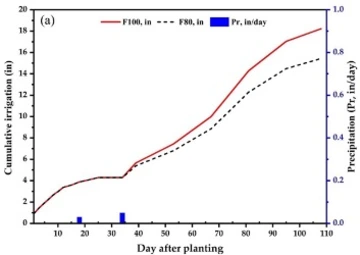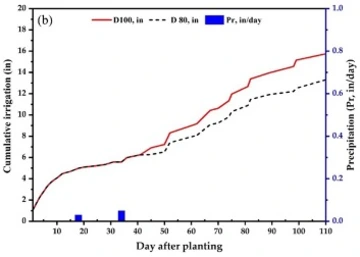Over a century ago, U.S. reclamation policy aimed to develop the West by providing water supplies for agriculture and other purposes (Hrozencik, 2021); however, agroecosystems in the U.S. Southwest are now vulnerable to water limitations due to the ongoing drought in the Colorado River basin, depletion of groundwater storage and reservoir water supplies, and increased distribution of water for industrial and municipal needs (Bennett et al., 2021; Castle et al., 2016).
In Arizona, approximately 72% of the state’s water supply is allocated to agriculture, with surface irrigation remaining the predominant method compared to pressurized systems (Pullen, 2023). This is mainly due to the existing infrastructure for conveying irrigation water from the Colorado River to farmers through irrigation canals (Elshikha et al., 2024). Reduced water allocations mandated for most of the water districts in Arizona due to the severe drought in the U.S. Southwest impose substantial challenges for growers in the state. Therefore, improvements in irrigation practices, systems, and management strategies are leading solutions for enhancing water productivity (WP) both in Arizona and around the world (Howell, 2001; Pereira et al., 2002). Additionally, climate change trends in the Desert Southwest (includes the arid and semi-arid desert landscapes in Arizona, California, Nevada, New Mexico, and Texas) further accelerates the inevitable risk of water shortage (Elsadek et al., 2024).
Adopting deficit irrigation strategies in arid and semi-arid regions according to crop growth stages and their sensitivity to water stress can improve on-farm management practices by reducing irrigation water use, decreasing evaporation losses, minimizing energy consumption, and increasing economic returns from investment in irrigation water supplies (Elsadek et al., 2023; Ragab, 2014). Moreover, improving soil quality by precisely estimating the salt leaching fraction (LF) and applying soil amendments and ameliorants as appropriate could enhance soil structure and increase water retention, leading to increased crop yield (Y). Additionally, soil amendments could reduce nutrient leaching by improving soil structure and increasing water retention, thereby promoting soil fertility (Zhang et al., 2023).
With recent advancements in pressurized irrigation systems, such as drip and center pivot, the importance of evaluating their performance has increased. This experiment compares the performance of three irrigation systems: flood, subsurface drip, and center pivot overhead sprinkler under varying irrigation rates and soil amendment application in a broccoli field. By assessing the effectiveness of each system, this research aims to provide Arizona growers with valuable information for optimizing irrigation practices to improve water-use efficiency and sustain crop yields.
Broccoli and irrigation scheduling
Broccoli (Brassica oleracea var. italica) is a cold-season vegetable closely related to the cauliflower and cabbage family (Patra et al., 2022). It is a shallow-rooted crop vulnerable to moisture and nutrient deficiency, thus, it requires frequent irrigation and fertilizer applications to ensure maximum crop production (Rajput et al., 2024).
Appropriate irrigation management is considered the most critical factor affecting broccoli quality and yield. In contrast, over-irrigation leads to leaching nutrients through deep percolation below the root zone, leading to reduced plant growth and yield. Meanwhile, under- irrigation causes water stress and yield reduction (Sakr et al., 2021). Therefore, there is an urgent necessity to optimize irrigation scheduling for broccoli, especially in water-limited regions, such as Arizona in the U.S. Desert Southwest.
Field trial and data analysis
A broccoli irrigation experiment was conducted at the University of Arizona Maricopa Agriculture Center in a 15-acre field equipped with three irrigation systems: flood (F), subsurface drip (D), and center pivot (CP). Two irrigation rates were evaluated for each irrigation system: 100% and 80% of crop evapotranspiration (ETc), applied to both amended (a) and non-amended soil. The study was carried out during the 2024 growing season using a planned experimental design with three replicate plots (R1, R2, and R3), Figure 1. Due to the water applied before the initiation of the variable rate, 80% ETc treatment became equivalent to 85% of ETc.
A total of five soil samples were randomly collected, with each sample consisting of six individual soil cores taken at 0.30-meter intervals, covering a total soil profile depth of 1.80 meters. The samples were mixed to form a single composite sample. Similarly, three water samples were combined to create a representative water sample. The salt leaching fraction (LF, %) was then determined through laboratory analysis using Equation 1 as follows (Ayers and Westcot, 1985):

(1) where ECw is the salinity of the applied irrigation water and ECsw is the salinity of soil water.
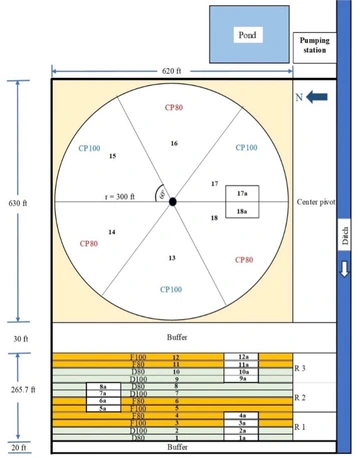
Figure 1. Field layout illustrating the flood (F), subsurface drip (D), and center pivot (CP) replicates (R) under different irrigation rates (100% and 80% crop evapotranspiration) with amended (a) and non-amended soil.
Liquid Natural Clay (LNC), a commercial soil amendment composed primarily of processed natural clay minerals (https://desertcontrol.com/, last accessed on March 31, 2025), was prepared on-site using the available irrigation water from the study location to maintain consistency with local water properties. It was applied to four experimental blocks, each measuring about 98 × 98 feet (Figure 1). Three blocks were included in the drip and flood irrigated plots, and the fourth block was under the center pivot. The LNC product, made by Desert Control Americas, Inc. was applied using an overhead sprinkler system equipped with impact sprinklers. The application was conducted after bed formation and prior to planting. Minimal soil cultivation, 4” deep, was performed in treated blocks immediately before planting and again approximately two weeks after application to facilitate LNC integration while preserving soil structure.
Broccoli was planted on October 01, 2024, and harvested by the end of January 2025. At the beginning of the broccoli season, a solid set sprinkler system was used to irrigate flood and drip plots until October 25, 2024. Once plants were established, varying irrigation rates were applied using flood irrigation (starting Nov. 8, 2024), drip irrigation (starting Nov. 14, 2024), and center pivot irrigation (starting Nov. 21, 2024) until the end of the growing season.
To investigate the effects of irrigation systems, water deficit stress, and soil amendments on the processes involved in photosynthesis during the reproductive growth stage, we conducted single-point survey measurements of gas exchange between 12:00 PM and 2:00 PM. These measurements were taken from the uppermost, fully expanded leaf using the LI-6800 portable photosynthesis system (LI-COR, Lincoln, NE). Among several gas exchange measurements, we focused on two important physiological characteristics of broccoli: net photosynthesis and stomatal conductance. Stomatal conductance describes the exchange of carbon dioxide and water vapor through plant stomata and typically correlates well with water-use efficiency. Net photosynthesis, on the other hand, is the process that converts solar energy into glucose for growth and development. Stomatal conductance and net photosynthesis were measured at the maturity stage using the LI-6800 portable photosynthesis system to determine the rate at which a plant converts carbon dioxide to glucose across treatments.
Broccoli heads were harvested on January 15, 18, and 26 in 2025 for flood, drip, and center pivot, respectively. The water productivity (WP, t/ac-in) was estimated using Equation 2 (Molden et al., 2010):
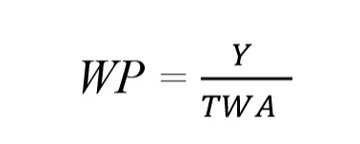
(2) where TWA is the total water applied (irrigation and precipitation) during the growing season.
Findings
Total water applied
The average total water applied (TWA) varied between 19.7 inches (F100) and 13.3 inches (D80a), as shown in Figure 2 and listed in Table 1. This amount was higher than Sanchez et al. (2023), who reported 17.9 inches for broccoli cultivated under sprinkler and furrow irrigation in Yuma, Arizona. This difference was primarily caused by the higher salinity in our field, resulting in the application of 24.5% more water to leach the salt compared with 2.8% more water in the Yuma field.
Figure 2. Cumulative irrigation and precipitation events for flood – F (a), subsurface drip – D (b), and center pivot – CP (c), under different irrigation rates (100% and 80% of crop evapotranspiration). Based on the salinity of the applied irrigation water (ECw) and the salinity of soil water (ECsw), the leaching fraction was 24.5%.
Yield and water productivity
The findings from this field experiment, including Yield (Y, t/ac), water productivity (WP, t/ac-in), TWA (in), leaching fraction (LF, in), and percentage changes in Y and TWA, compared to F100, during the broccoli growing season, are summarized in Table 2. Yields in this preliminary trial ranged from 7.2 t/ac under the CP100 treatment to 9.3 t/ac under the D100a treatment, with the latter saving approximately 19.8% of irrigation water compared to the F100. Further water savings were observed with the D80a treatment, which reduced water use by 32.5% relative to flood irrigation (F100) while maintaining a yield of 9.1 t/ac. Remarkably, subsurface drip irrigation demonstrated reasonable performance under deficit irrigation, achieving a 32.5% reduction in irrigation water compared to flood irrigation at 100% of the calculated ETc. A WP of 0.36 t/ac-in was observed with the F100 treatment, compared to 0.68 t/ac-in with the D80a treatment, aligning with previous studies by Elshikha et al. (2023), Ragab (2014), and Elsadek et al. (2023), which highlight the benefits of deficit irrigation in arid regions. While center pivot irrigation also contributed to water conservation, achieving similar savings as subsurface drip, its yield benefits were only evident under deficit irrigation when soil amendments were applied (CP80a). Overall, the performance of subsurface drip irrigation indicates its potential as a sustainable irrigation system for regions with limited water resources. Although the soil amendment was not applied to the entire plot to directly evaluate water savings, it resulted in a 5.8-14.4% increase in yield when the F80 treatment was excluded.
Table1. Summary of the irrigation and yield data during the broccoli growing season at the University of Arizona Maricopa Agriculture Center, Arizona.
| System | Flood (F) | Subsurface drip (D) | Center pivot (CP) | |||||||||
| Treatment | F100 | R100a | F80 | F80a | F100 | R100a | F80 | F80a | F100 | R100a | F80 | F80a |
| TWA, in | 19.7 | 16.8 | 15.8 | 13.3 | 16.4 | 14.0 | ||||||
| LF, in | 4.8 | 4.1 | 3.9 | 3.3 | 4.0 | 3.4 | ||||||
| Y, t/ac | 7.80 | 8.40 | 8.50 | 7.90 | 8.50 | 9.30 | 8.60 | 9.10 | 7.20 | 8.00 | 7.60 | 8.70 |
| %change in TWA compared to F100 | 0 | -14.9 | -19.8 | -32.5 | -16.6 | -29.1 | ||||||
| % change in Y compared to F100 | 0 | 7.7 | 9 | 1.3 | 9 | 19.2 | 10.3 | 16.7 | -7.7 | 2.6 | -2.6 | 11.5 |
| WP,t/ac-in | 0.4 | 0.43 | 0.51 | 0.47 | 0.54 | 0.59 | 0.65 | 0.68 | 0.44 | 0.49 | 0.54 | 0.62 |
Note: TWA, LF, Y, and WP refer to total water applied, leaching fraction, yield, and water productivity, respectively. The letter "a" added to the abbreviation of the irrigation treatment denotes the soil amendment. The leaching fraction (LF) for our field was 24.5% based on the salinity of the applied irrigation water (ECw) and the salinity of soil water (ECsw).
Impact of irrigation and soil amendment on plant physiology
Pressurized systems, drip and center pivot overhead sprinklers, may have enhanced the exchange of carbon dioxide and water compared to the flood. Furthermore, net photosynthesis tended to be higher with center pivot and subsurface drip irrigation compared to flood irrigation (Figure 3). Additionally, the LNC soil amendment enhanced stomatal conductance and net photosynthesis under all the tested systems, which might have contributed to the higher water productivity, especially at 80% ETc irrigation rate.
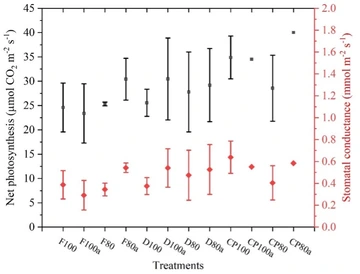
Figure 3. Variations in net photosynthesis and stomatal conductance at maturity under different irrigation methods: flood (F), subsurface drip (D), and center pivot (CP), and irrigation rates (100% and 80% of crop evapotranspiration) with amended (a) and non-amended soil.
Recommendations
The evaluation of three irrigation methods, flood, subsurface drip, and center pivot, at varying irrigation rates and soil conditions indicated that subsurface drip irrigation, combined with soil amendments, resulted in the highest yield and water productivity (Table 1). The 100% subsurface drip treatment, with 100% replacement of calculated ETc, and the 80% drip treatment had yields of 9.3 and 9.1 t/ac, respectively, and they required water application depths of 15.8 and 13.1 inches, which resulted in water productivities of 0.59 and 0.68 t/ac-in. The flood and center pivot irrigated treatments had significantly lower yields and water productivities. These findings suggest that using subsurface drip irrigation at reduced application rates with soil amendments can maximize broccoli yields and water productivity. However, the long-term effects of the soil amendment need further investigation.
Salinity issues may potentially arise when using pressurized irrigation systems. High water salinity, particularly with sprinkler systems, may stress plants, especially during establishment, and contribute to salt buildup in the soil. For drip irrigation, leaching salt below the root zone and continuous monitoring of system performance are important to minimize salinity issues. Also, scheduled maintenance of irrigation systems is essential to avoid unplanned repairs and ensure system reliability.
Flood irrigation can be efficient when water is applied at an appropriate flow rate, which is influenced by factors such as furrow dimensions, field length, soil type, and slope. In our field, optimal efficiency was achieved by irrigating at flow rates exceeding 25 gallons per minute (GPM) per furrow. To maintain consistent flow, we utilized a trash pump and gated pipes. However, achieving this level of control may not be feasible on a typical farm due to variations in ditch flow rate and field conditions.
Acknowledgement
This work was supported by the University of Arizona Cooperative Extension Water Irrigation Efficiency Program, which is funded by the Arizona State Legislature.
Disclaimer
This publication provides an objective summary of an irrigation experiment and does not endorse or promote any particular brand, product, or trademark. Any references to product names, trademarks, or companies are included for informational purposes only.
References
- Ayers, R.S., Westcot, D.W., 1985. Water quality for agriculture. FAO, Rome, Italy.
- Bennett, K.E., Talsma, C., Boero, R., 2021. Concurrent Changes in Extreme Hydroclimate Events in the Colorado River Basin. Water 13. https://doi.org/10.3390/w13070978
- Castle, S.L., Reager, J.T., Thomas, B.F., Purdy, A.J., Lo, M.- H., Famiglietti, J.S., Tang, Q., 2016. Remote detection of water management impacts on evapotranspiration in the Colorado River Basin. Geophys. Res. Lett. 43, 5089–5097. https://doi.org/10.1002/2016GL068675
- Elsadek, E., Zhang, K., Mousa, A., Ezaz, G.T., Tola, T.L., Shaghaleh, H., Hamad, A.A.A., Alhaj Hamoud, Y., 2023. Study on the In-Field Water Balance of Direct- Seeded Rice with Various Irrigation Regimes under Arid Climatic Conditions in Egypt Using the AquaCrop Model. Agronomy 13, 609. https://doi.org/10.3390/ agronomy13020609
- Elsadek, E.A., Zhang, K., Hamoud, Y.A., Mousa, A., Awad, A., Abdallah, M., Shaghaleh, H., Hamad, A.A.A., Jamil, M.T., Elbeltagi, A., 2024. Impacts of climate change on rice yields in the Nile River Delta of Egypt: A large- scale projection analysis based on CMIP6. Agric. Water Manag. 292, 108673. https://doi.org/10.1016/j.agwat.2024.108673
- Elshikha, D.E., Attalah, S., Elsadek, E.A., Waller, P., Thorp, K., Sanyal, D., Bautista, E., Norton, R., Hunsaker, D., Williams, C., Wall, G., Barnes, E., Orr, E., 2024. The Impact of Gravity Drip and Flood Irrigation on Development, Water Productivity, and Fiber Yield of Cotton in Semi-Arid Conditions of Arizona, in: 2024 Anaheim, California July 28-31, 2024. American Society of Agricultural and Biological Engineers, St. Joseph, MI, pp. 1–16. https://doi.org/10.13031/aim.202400004
- Elshikha, D.E.M., Wang, G., Waller, P.M., Hunsaker, D.J., Dierig, D., Thorp, K.R., Thompson, A., Katterman, M.E., Herritt, M.T., Bautista, E., Ray, D.T., Wall, G.W., 2023. Guayule growth and yield responses to deficit irrigation strategies in the U.S. desert. Agric. Water Manag. 277, 108093. https://doi.org/10.1016/j.agwat.2022.108093
- Howell, T.A., 2001. Enhancing Water Use Efficiency in Irrigated Agriculture. Agron. J. 93, 281–289. https://doi.org/10.2134/agronj2001.932281x
- Hrozencik, R.A., 2021. Trends in US irrigated agriculture: increasing resilience under water supply scarcity [WWW Document]. URL https://ssrn.com/abstract=3996325 or http://dx.doi.org/10.2139/ssrn.3996325 (accessed 2.27.25).
- Molden, D., Oweis, T., Steduto, P., Bindraban, P., Hanjra, M.A., Kijne, J., 2010. Improving agricultural water productivity: Between optimism and caution. Agric. Water Manag. 97, 528–535. https://doi.org/10.1016/j.agwat.2009.03.023
- Pereira, L.S., Oweis, T., Zairi, A., 2002. Irrigation management under water scarcity. Agric. Water Manag. 57, 175–206. https://doi.org/10.1016/S0378-3774(02)00075-6
- Pullen, J., 2023. Water Use by Sector Tucson, Arizona MSA [WWW Document]. URL https://mapazdashboard.arizona.edu/article/arizonas-water-use-sector (accessed 3.2.25).
- Ragab, R., 2014. A note on water use efficiency and water productivity. Water4Crops 1–11.
- Rajput, J., Singh, M., Lal, K., Khanna, M., Sarangi, A., Mukherjee, J., Singh, S., Dimple, 2024. Development of single and dual crop coefficients for drip-irrigated broccoli using weighing type field lysimeters in semi- arid environment. Environ. Dev. Sustain. https://doi.org/10.1007/s10668-024-05416-5
- Sakr, M.T., Ibrahim, H.M., ElAwady, A.E., AboELMakarm, A.A., 2021. Growth, yield and biochemical constituents as well as post-harvest quality of water-stressed broccoli (Brassica oleraceae L. var. italica) as affected by certain biomodulators. Sci. Hortic. (Amsterdam). 275, 109605. https://doi.org/10.1016/j. scienta.2020.109605
- Sanchez, C., French, A., Anderson, R., Hunsaker, D., Saber, M., Subramani, J., William, C., Wisniewski, E., Zerihun, D., 2023. Quantitative Assessments of Water and Salt Balance for Cropping Systems in the Lower Colorado River Region. The University fo Arizona Yuma Center of Excellence for Desert Agriculture (https://www.desertagsolutions.org, last accessed on March 10, 2025).
- Zhang, C., Zhao, X., Liang, A., Li, Y., Song, Q., Li, X., Li, D., Hou, N., 2023. Insight into the soil aggregate- mediated restoration mechanism of degraded black soil via biochar addition: Emphasizing the driving role of core microbial communities and nutrient cycling. Environ. Res. 228, 115895. https://doi.org/10.1016/j.envres.2023.115895


